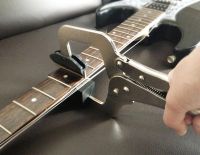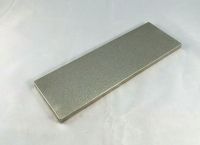25 Piece Set - Jescar Stainless Steel Fretwire #47104 - Jumbo Gauge
In stock
SKU
FW-021-47104-25
$62.50
- Buy 3 for $56.25 each and save 10%
- Made by Jescar in USA
- Super hard Stainless Steel for superior durability
- Resists wear & tarnishing
- 25 cut pieces 70mm (3-3/4") lengths, enough for 1 guitar
- Bent to 10" radius, can be straightened or bent more if needed
- Width - 2.64mm (0.104")
- Crown Height - 1.19mm (0.047")
- Tang Height - 1.55mm (0.061")
- Fits a standard width slot approximately 0.58mm (0.023")
Stainless Steel is the hardest and most durable fretwire available. It is becoming popular, especially for use on electric guitars.
Due to the hardness of Stainless Steel, frets made from this metal lasts much longer than the traditional nickel-silver frets. Stainless frets will likely never wear out making refretting unnecessary.
Stainless Steel frets add a hint of brightness to the tone of a guitar.
It is best to use diamond coated files when working with Stainless frets.
Jumbo Gauge frets are very popular for electric, archtop or bass guitars, they are also often used on fingerstyle acoustic guitars as they make string bending easier. Jumbo Gauge fretwire is ideal for refretting modern Fender guitars.
See below for more info about choosing fretwire.
Related Products
We found other products you might like!
Stainless Steel Fretwire is becoming a popular choice, especially on electric guitars. Our stainless fretwire is made by Jescar in the USA.
Stainless is super hard, this means the frets won't ever wear out from string-wear.
The drawback of stainless frets is that they're relatively difficult to install. The metal isn't as malleable as nickel so it is harder to get seated against the fingerboard. The frets are also much harder and time-consuming to file and polish, diamond-coated tools are a must!
Radius - Our Stainless Steel fretwire comes with a radius of approximately 10". It can be straightened for flatter fingerboards or bent more for tighter fingerboards. It's better for the fretwire to be slightly 'overbent' to a tighter radius as it will help keep the ends of the frets down against the fingerboard
Choosing Fretwire
Slot Width and Compatibility - The width of the slots in the fingerboards of guitars and other instruments is usually quite standard and all of our fretwires will fit the majority of guitar fingerboards. A slot width of 0.55-0.6mm (0.022-0.024”) is standard.
The tang (the part of the fret that goes in the slot) is always wider than the slot, especially where it has knobs on the sides. This extra width helps hold the fret firmly in place in the slot.
Fretting a New Guitar - If you are building a guitar you can use any size fretwire. You can look at the description of each fretwire type we stock for guidance as to which instruments it’s best suited to. In general you can’t go wrong with the Standard/Medium, Oversize Medium and Jumbo/Large sizes on most acoustic and electric guitars.
Refretting a Guitar - If you are replacing the frets in an existing guitar it’s conventional to choose a size of fretwire which closely matches the original fretwire. Unless the owner of the guitar specifically wants a different size of fretwire it’s best to use a gauge of wire that matches the dimensions if the fretwire used used when the guitar was made.
Accurate measurement of the width and height of the original frets is important and the best way to measure these is with our Luthiers Digital Caliper.
Size - Fretwire is available in a number of different sizes. Some guitarists prefer a particular size of frets while others don’t notice much difference.
If you are unsure of what size to buy the safest sizes are Medium, Oversize Medium and Jumbo.
Width - As a loose rule narrower gauge frets are preferred for rhythm guitar, while wider gauges are better suited to string bending and lead playing. Some players prefer narrower frets as they give a little more space between the frets.
Height - The height of the frets is a personal preference. Some players prefer the feel of low frets while others don't like them because their fingers are too close to the fingerboard.
Very Large Frets are becoming popular, especially on electric guitars and amongst metal guitarists. Super Jumbo fretwire is a little wider and taller than traditional jumbo frets and Double Jumbo is larger still.
If you are unsure of what size to buy the safest sizes are Medium, Oversize Medium and Jumbo.
Stainless is super hard, this means the frets won't ever wear out from string-wear.
The drawback of stainless frets is that they're relatively difficult to install. The metal isn't as malleable as nickel so it is harder to get seated against the fingerboard. The frets are also much harder and time-consuming to file and polish, diamond-coated tools are a must!
Radius - Our Stainless Steel fretwire comes with a radius of approximately 10". It can be straightened for flatter fingerboards or bent more for tighter fingerboards. It's better for the fretwire to be slightly 'overbent' to a tighter radius as it will help keep the ends of the frets down against the fingerboard
Choosing Fretwire
Slot Width and Compatibility - The width of the slots in the fingerboards of guitars and other instruments is usually quite standard and all of our fretwires will fit the majority of guitar fingerboards. A slot width of 0.55-0.6mm (0.022-0.024”) is standard.
The tang (the part of the fret that goes in the slot) is always wider than the slot, especially where it has knobs on the sides. This extra width helps hold the fret firmly in place in the slot.
Fretting a New Guitar - If you are building a guitar you can use any size fretwire. You can look at the description of each fretwire type we stock for guidance as to which instruments it’s best suited to. In general you can’t go wrong with the Standard/Medium, Oversize Medium and Jumbo/Large sizes on most acoustic and electric guitars.
Refretting a Guitar - If you are replacing the frets in an existing guitar it’s conventional to choose a size of fretwire which closely matches the original fretwire. Unless the owner of the guitar specifically wants a different size of fretwire it’s best to use a gauge of wire that matches the dimensions if the fretwire used used when the guitar was made.
Accurate measurement of the width and height of the original frets is important and the best way to measure these is with our Luthiers Digital Caliper.
Size - Fretwire is available in a number of different sizes. Some guitarists prefer a particular size of frets while others don’t notice much difference.
If you are unsure of what size to buy the safest sizes are Medium, Oversize Medium and Jumbo.
Width - As a loose rule narrower gauge frets are preferred for rhythm guitar, while wider gauges are better suited to string bending and lead playing. Some players prefer narrower frets as they give a little more space between the frets.
Height - The height of the frets is a personal preference. Some players prefer the feel of low frets while others don't like them because their fingers are too close to the fingerboard.
Very Large Frets are becoming popular, especially on electric guitars and amongst metal guitarists. Super Jumbo fretwire is a little wider and taller than traditional jumbo frets and Double Jumbo is larger still.
If you are unsure of what size to buy the safest sizes are Medium, Oversize Medium and Jumbo.
| Manufacturer | Jescar |
|---|---|
| Size | Large, Jumbo |
| Metal | Stainless Steel |
| For Instrument | Acoustic Guitar, Electric Guitar, Bass Guitar, Archtop Guitar |















